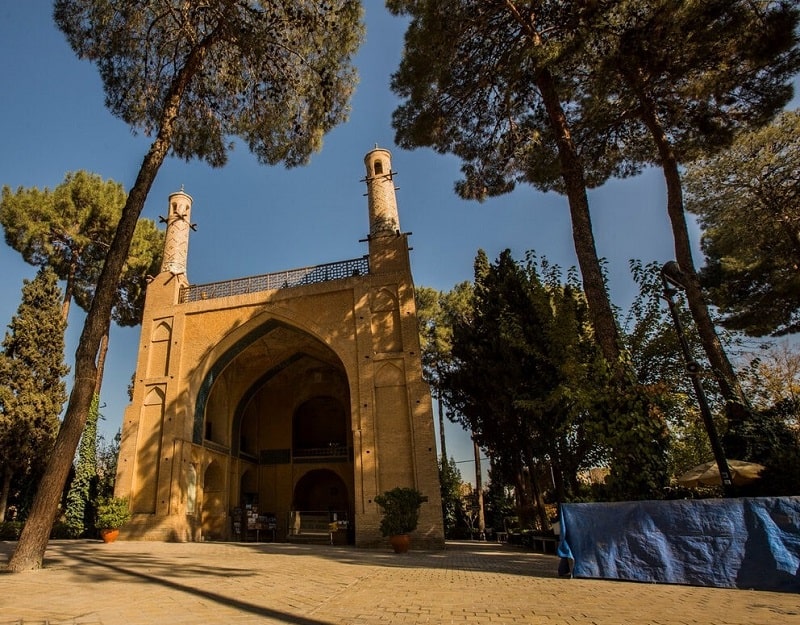Introduction to Monar Jonban
700 years ago, while Europe was involved with conflict between logic, church discourses, and gospel narrations, people in the warm, sunny lands of Middle East, in a way, sought to discover, build, and invent, and subsequently came up with unique mathematical and engineering rules and used them in building construction. Like the magnificent engineering of Monar Jonban Structure, in the city of Isfahan, some of these formulas remain a mystery, and scientists are still trying to unravel them; A human phenomenon which has turned the scientists dumb-founded.

History of Monar Jonban
Monar Jonban is one of the amazing structures in Persia, dating back to more than 700 years ago, during the region of “Sultan Mohammad Khodabandeh Al-Jaito” the last Ilkhan ruler, as a tomb for “Amu Abdullah” a mystic, and ascetic of the patriarchal period. At first, there was no minarets build, and the tomb included a 10 meters-high brick porch, and later, the Safavid scholars added two 17.5 meters minarets on this tomb to differentiate it from other monuments in the city.
Naming of Monar Jonban
The monument takes its name from the two moving minarets on either side of the structure. These minarets shake by moving the lever at the top of the minaret on the right, which will cause the left minaret to shake. To reach that handspike, we should cross through a small gate that leads to the roof with spiral stairs.
Hidden Features of Monar Jonban
Many researchers still believe that there is no logical reason for this feature. However, the most agreeable argument is the physical phenomenon of Resonance or, the Doppler Effect. According to this theory, the motion frequency of an object changes due to the motion of the transmitter or receiver. This happens when the height, weight, and the density of both objects are in the same amount. This process has continued from the beginning of the construction of the minarets until now. Given the antiquity of the building, the question arises as to whether these shocks should not have caused the destruction of the minarets?
The answer to this question is in the architecture and the construction of the monument; The presence of two 3 cm deep splits on the sides of the minarets, the construction of square wooden spools as a flexible support at the top and bottom of the minaret, utilization of light construction materials in the structure of the upper part of the monument, and the low height of the minarets, all and all has made the minarets strong and not collapse during these years.
How the Minarts shack
The person who is called the mover is responsible for shaking the lever of the minaret. He is the only one who is allowed to climb the stairs of the minaret and shake the minarets. Of course, in the past, visitors could also shake the minarets individually; But now it is banned for better protection of the building. In the past, the muezzin would go to the top of the minarets to say the call to prayer and say the call to prayer while shaking the minarets.
Architecture of Monar Jonban
The Monar Jonban includes a porch, two magnificent minarets, and an apron. The building is decorated with four-pointed star azure tiles, and delightful turquoise polygons. The exterior of the monument is decorated with light brown brick. The Monar Jonban includes two small rooms, that were used as the Cheleh Khane in ancient times. Cheleh Khane is the place where mystics and ascetics spent their 40-day seclusion and austerities. At the time of the construction of, the area around the monument was a cemetery, all that remains of which, are a few tombs with white tombstones near the porch.
The World Shaking Buildings
Monar Jonban is not the only building in Persia which includes this feature; The most famous of which is the Kharanagh Minaret in Ardakan city, in Yazd Province. And we should know that Persia is not the only country in whole world that has kept such magnificent architectural masterpiece in its heart. We can find examples of which in other countries, such as Iraq and Saudi Arabia. It is interesting to note that all these constructions were built in a short time compared to each other, but the difference between the Monar Jonban of Isfahan, and other similar structures is its movement, which with the movement of one minaret, not only the other minaret, but also the whole building begins to shakes.

